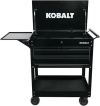- Joined
- May 24, 2016
- Messages
- 961
- Display Name
Display name:
4RNB
tldr: I want to build an RV10, looking for advice on my shop plans
Background: I own a nice C172 but desire more speed. I have found going 182 route of limited benefit due to small improvement. Was surprised how much I liked test flight with Zach (Vans RV factory rep), now build obsessed. Starting AP school in August of 2024, otherwise retired. To build at home I'd want to get a nice set up ready, have some things in mind. I took a video of the proposed area, looking for further ideas and feedback. The building is a 60x16 three sided shed. I'd likely enclose either 30x16 (the middle section plus one half of concrete floor area), 50x16 (I think best, half the concrete section plus the rest), or else 40x16 (just the rock floor area). I already have a nice air compressor. There is 100 amp service at the building, I'd aim for LED lights overhead, outlets along the walls, and a ductless mini split HVAC system for the whole area. Is any of the equipment for the build voltage sensitive? We have solar at our house, each of our inverters adds a volt to the load to "push" excess generation back to the street. Sometimes we see 253V on our 240V circuits and have to get a fancy transformer to step down the HVAC line voltage. Nothing else in the house affected. I'd probably consider a taller bench system as I am 6'6", aim to have most outlets above the benches. What kind of finish should I put on the floors? I can paint over concrete, or maybe some tile? I think of bare concrete as maybe being too dusty? Should I leave the space all open or close off 10x16 area for priming/painting? If I enclose for paint, how should I evacuate the air? How wide of a garage door do I need for kits and getting the wheeled plane out? The building has solar on it with some screwed penetrations, minimal leakage. I wonder if I should make a flat interior ceiling with overtop decked roof. This would prevent any water getting in and add some minimal dry though cramped storage. I'd consider spray foam insulation for tightness.
My plan would be to do the following, most of it hired out:
Clean up space
Contract out concrete pour
Rough in framing
Install siding
Rough in electric
Insulate
Interior walls
finish electric
install doors
I think this could end being a fun but frustrating project. I think I will cover the walls with other peoples first flight photos for motivation.
How does this space look to you and what would you do differently than I propose?
Video below
Background: I own a nice C172 but desire more speed. I have found going 182 route of limited benefit due to small improvement. Was surprised how much I liked test flight with Zach (Vans RV factory rep), now build obsessed. Starting AP school in August of 2024, otherwise retired. To build at home I'd want to get a nice set up ready, have some things in mind. I took a video of the proposed area, looking for further ideas and feedback. The building is a 60x16 three sided shed. I'd likely enclose either 30x16 (the middle section plus one half of concrete floor area), 50x16 (I think best, half the concrete section plus the rest), or else 40x16 (just the rock floor area). I already have a nice air compressor. There is 100 amp service at the building, I'd aim for LED lights overhead, outlets along the walls, and a ductless mini split HVAC system for the whole area. Is any of the equipment for the build voltage sensitive? We have solar at our house, each of our inverters adds a volt to the load to "push" excess generation back to the street. Sometimes we see 253V on our 240V circuits and have to get a fancy transformer to step down the HVAC line voltage. Nothing else in the house affected. I'd probably consider a taller bench system as I am 6'6", aim to have most outlets above the benches. What kind of finish should I put on the floors? I can paint over concrete, or maybe some tile? I think of bare concrete as maybe being too dusty? Should I leave the space all open or close off 10x16 area for priming/painting? If I enclose for paint, how should I evacuate the air? How wide of a garage door do I need for kits and getting the wheeled plane out? The building has solar on it with some screwed penetrations, minimal leakage. I wonder if I should make a flat interior ceiling with overtop decked roof. This would prevent any water getting in and add some minimal dry though cramped storage. I'd consider spray foam insulation for tightness.
My plan would be to do the following, most of it hired out:
Clean up space
Contract out concrete pour
Rough in framing
Install siding
Rough in electric
Insulate
Interior walls
finish electric
install doors
I think this could end being a fun but frustrating project. I think I will cover the walls with other peoples first flight photos for motivation.
How does this space look to you and what would you do differently than I propose?
Video below

